


The Jefferson County, Florida paleontological sites are assemblages of Mid-Miocene to Late Pleistocene vertebrates from Jefferson County, Florida, United States.



The Jefferson County, Florida paleontological sites are assemblages of Mid-Miocene to Late Pleistocene vertebrates from Jefferson County, Florida, United States.
Era : Neogene
Period : Miocene to Pleistocene, ~23.03 Mya—11,000 years ago. (calculates to a period of approximately 22.92 million years).
Faunal stage : Clarendonian through early Rancholabrean
Ashville site (Miocene) Time period: ~13.5—12.7 Mya. [1]
Aucilla River site (Pleistocene) Time period: ~126,000—11,000 years ago. The Aucilla site specimens were discovered by amateur paleontologist Dr. Richard Ohmes of Bremerton, Washington in 1969. [2]
Coordinates: 30°06′N83°54′W / 30.1°N 83.9°W
Wacissa River site (Pleistocene) Time period: ~126,000—11,000 years ago. Collected by R. Alexon, B. Mathen, R. Gingery in October 1981; in shallow water. Specimens reposited in the Florida Museum of Natural History. [3]
Coordinates: 30°24′N83°54′W / 30.4°N 83.9°W
Ashland site = ASH. Aucilla River site = ARS. Wacissa River site = WRS.

Jefferson County is a county located in the Big Bend region in the northern part of the U.S. state of Florida. As of the 2020 census, the population was 14,510. Its county seat is Monticello. Jefferson County is part of the Tallahassee, FL Metropolitan Statistical Area but is the 3rd most rural county in Florida. There are no traffic signals within the entire county.
The Page–Ladson archaeological and paleontological site (8JE591) is a deep sinkhole in the bed of the karstic Aucilla River that has stratified deposits of late Pleistocene and early Holocene animal bones and human artifacts. The site was the first pre-Clovis site discovered in southeastern North America; radiocarbon evidence suggests that the site dates from 14,200 to 14,550 BP(12,250 to 12,600 BCE). These dates are roughly 1,000 to 1,500 years before the advent of the Clovis culture. Early dates for Page–Ladson challenge theories that humans quickly decimated large game populations in the area once they arrived.
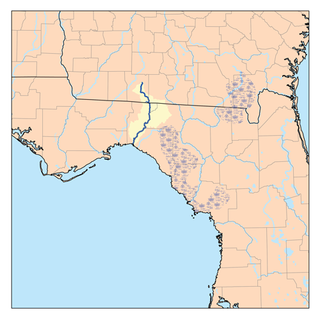
The Aucilla River rises in Brooks County, Georgia, USA, close to Thomasville, and passes through the Big Bend region of Florida, emptying into the Gulf of Mexico at Apalachee Bay. Some early maps called it the Ocilla River. It is 89 miles (143 km) long and has a drainage basin of 747 square miles (1,930 km2). Tributaries include the Little Aucilla and Wacissa Rivers. In Florida, the Aucilla River forms the eastern border of Jefferson County, separating it from Madison County on the northern part, and from Taylor County to the south.

The Middle Awash is a paleoanthropological research area in the northwest corner of Gabi Rasu in the Afar Region along the Awash River in Ethiopia's Afar Depression. It is a unique natural laboratory for the study of human origins and evolution and a number of fossils of the earliest hominins, particularly of the Australopithecines, as well as some of the oldest known Olduwan stone artifacts, have been found at the site—all of late Miocene, the Pliocene, and the very early Pleistocene times, that is, about 5.6 million years ago (mya) to 2.5 mya. It is broadly thought that the divergence of the lines of the earliest humans (hominins) and of chimpanzees (hominids) was completed near the beginning of that time range, or sometime between seven and five mya. However, the larger community of scientists provide several estimates for periods of divergence that imply a greater range for this event, see CHLCA: human-chimpanzee split.

Bison antiquus is an extinct species of bison that lived in North America during the Late Pleistocene from over 60,000 years ago until around 10,000 years ago. Bison antiquus was one of the most common large herbivores in North America during this time period. It is the direct ancestor of the living American bison.

Bison latifrons, also known as the giant bison or long-horned bison, is an extinct species of bison that lived in North America during the Late Pleistocene epoch ranging from southern Canada to Mexico. It is noted for its large body size and its distinctive long horns.

The Wacissa River is a large, spring-fed stream located in south-central Jefferson County, Florida. Its headwaters are located about a mile south of the town of Wacissa, where the river emerges crystal clear from a group of large limestone springs. From its headsprings, the river flows approximately 12 miles (19 km) south through a broad cypress swamp before breaking into numerous braided channels which join the Aucilla River a few miles further south. The river is managed by the Florida Fish & Wildlife Conservation Commission as part of the Aucilla Wildlife Management Area, and has been declared an Outstanding Florida Waterway by the Florida Department of Environmental Protection.

Melbourne Bone Bed is a paleontological site located at Crane Creek in Melbourne, in the U.S. state of Florida. This site contains fossils from the Late Pleistocene period 20,000 to 10,000 years before the present. The fossils include extinct animals such as varieties of llamas, dire wolves, Florida cave bears, giant armadillos, giant beavers, giant bison, giant ground sloths, mammoths, mastodons, saber-toothed cats, and tapirs.

Nannippus is an extinct genus of three-toed horse endemic to North America during the Miocene through Pleistocene, about 13.3—1.8 million years ago (Mya), living around 11.5 million years. This ancient species of three-toed horse grew up to 3.5 feet and weighed between 165 pounds to 199 pounds, which was around the same size as a domestic sheep.

Tremarctos floridanus is an extinct species of bear in the family Ursidae, subfamily Tremarctinae. T. floridanus became extinct at the end of the last ice age, 11,000 years ago. Its fossils have been found throughout the Southeastern United States, in northeastern Mexico, and in Belize from the Rancholabrean epoch, and from earlier epochs at some sites in western North America.
J&J Hunt Site (8JE740) is an inundated prehistoric archaeological site located 6 km off the coast of northwestern Florida. The site which was discovered in 1989 is located in 3.7 to 4.6 m of salt water in the Gulf of Mexico along the PaleoAucilla River. In prehistory the site had at least two different occupations: a Late Paleoindian-Early Archaic and Middle Archaic. The J&J Hunt site was a major focus of the PaleoAucilla Prehistory Project conducted by Michael K. Faught.
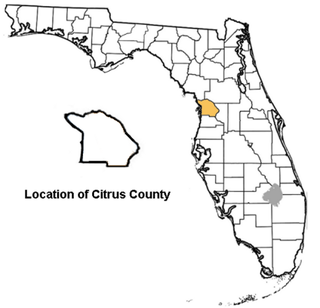
The Inglis quarry or Inglis quarry sites 1A and 1C are assemblages of vertebrate fossils dating from the Pleistocene ~1.8 Mya—300,000 years ago, located in the phosphate quarries near the town of Inglis, Citrus County, northern Florida.
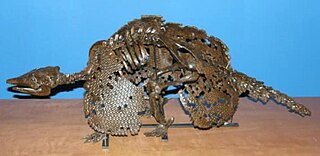
Pachyarmatherium is a genus of extinct large armadillo-like cingulates found in North and South America from the Pliocene and Pleistocene epochs, related to the extant armadillos and the extinct pampatheres and glyptodonts. It was present from 4.9 Mya to 11,000 years ago, existing for approximately 4.889 million years.

The Haile Quarry or Haile sites are an Early Miocene and Pleistocene assemblage of vertebrate fossils located in the Haile quarries, Alachua County, northern Florida. The assemblage was discovered during phosphate mining, which began in the late 1940s. Haile sites are found in the Alachua Formation. Two sites within the Ocala Limestone yielded Upper Eocene Valvatida and mollusks.

The Leon County paleontological sites are assemblages of Early Miocene invertebrates and vertebrates of Leon County, Florida, United States.
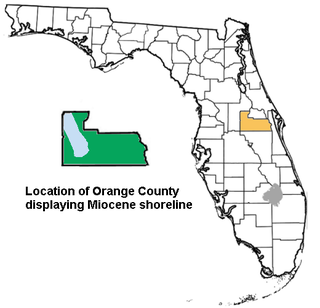
The Orange County paleontological sites are assemblages of Late Pleistocene vertebrates occurring in Orange County, Florida.
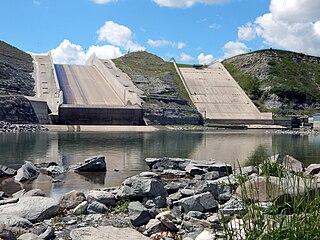
St. Mary Reservoir is a reservoir in southwestern Alberta, Canada. It was created for irrigation purposes by the damming of the St. Mary River, which was completed in 1951. The Kainai Nation's Blood 148 Indian reserve borders its northwest side. There are camping and picnic areas at the reservoir, and it is a popular site for power boating, water skiing, windsurfing, swimming and fishing.
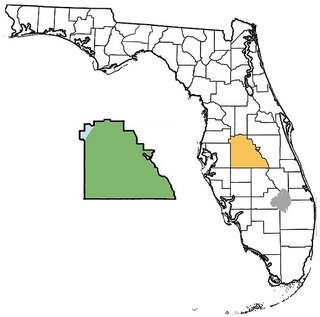
The Polk County paleontological sites are assemblages of Early Miocene to Late Pleistocene vertebrates occurring in Polk County, Florida, United States.

Lamb Spring is a pre-Clovis prehistoric Paleo-Indian archaeological site located in Douglas County, Colorado with the largest collection of Columbian mammoth bones in the state. Lamb Spring also provides evidence of Paleo-Indian hunting in a later period by the Cody culture complex group. Lamb Spring was listed in 1997 on the National Register of Historic Places.

Aucilla Wildlife Management Area conserves 50,549 acres of hydric hammock, mesic flatwoods, upland forest, and spring-run river twelve miles southeast of Tallahassee in Jefferson and Taylor Counties in Florida.